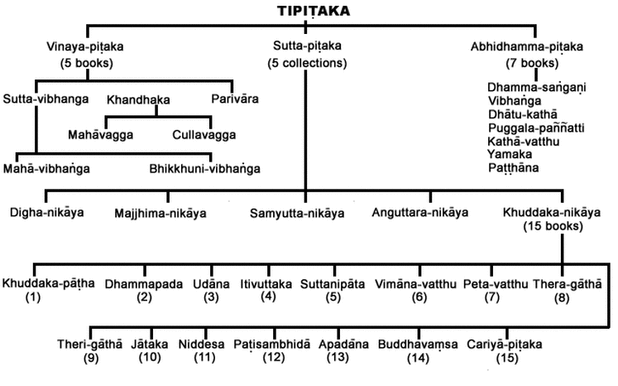Structured Tree Flow of TIPITAKA
|
http://www.tipitaka.org/
 This web site is based on the Chaṭṭha Saṅgāyana CD published by the Vipassana Research Institute.
This web site is based on the Chaṭṭha Saṅgāyana CD published by the Vipassana Research Institute.
Based at Dhamma Giri, Igatpuri, near Mumbai, India, the Vipassana
Research Institute also publishes literature & disseminates
information related to Vipassana Meditation Technique as taught by S.N.Goenka in the tradition of Sayagyi U Ba Khin.
Vipassana
is a universal, scientific method towards purifying the mind. It is the
practical essence of the teachings of the Buddha, who taught Dhamma -
the Universal Law of Nature.
The Pāḷi Tipiṭaka is now available
online in various scripts. Although all are in Unicode fonts, you may
need to install some fonts and make some changes to your system to view
the site correctly.
Please read the help page carefully for more information on setting up your system and also on how to use this site.
New Desktop software: You can now download the entire Chaṭṭha Saṅgāyana Tipitaka to run off your computer in offline mode. Click here for instructions.
New iOS web app: You can now navigate the Chaṭṭha Saṅgāyana Tipitaka using your iPhone, iPod Touch, or iPad. Click here for instructions.
Older Operating systems: Vistors using Windows 95/98 may not be able to view Unicode texts as it is not fully supported by these operating systems. The older VRI Roman site is still available. To use the VRI Roman site you will need to install the VRI Roman Pali fonts. Alternatively you may download an image of the CSCD3 disc (208 MB) and burn your own copy of CSCD3.
In case of difficulties in viewing the Pāḷi Text or if you notice any other errors on this site, please write to help@tipitaka.org describing the problem.
https://www.youtube.com/watch?
1) Classial Magadhi Meaning and origin
When a just born baby is separated and kept isolated it will speak a
natural (Prakriti) human language just like any other living beings such
as birds, animals, insects communicate in their languages.That natural
Human language is Magadhi.
ADictionary
Published on Apr 25, 2015
Video shows what Magadhi means. An Indo-Iranian language, spoken
primarily in the Bihar state of India.. Magadhi Meaning. How to
pronounce, definition audio dictionary. How to say Magadhi. Powered by
MaryTTS, Wiktionary
Category
Education
shows what Magadhi means. An Indo-Iranian language, spoken primarily in
the Bihar state of India.. Magadhi Meaning. How to pronounce,
definition…
This
outline displays the publication of books in the Devan±gari-script
edition of the Chaμμha Saag±yana (Sixth Council) Tipiμaka. The names of
the volumes are displayed in italics with the suffix “-p±1⁄4i” indicating
the volume is part of the root Tipiμaka, rather than commentarial
literature. This outline lists the root volumes only.
Please note: These books are in P±li only, in Devan±gari script, and are not for sale.
No set of English translations is available. For further information please see: www.tipitaka.org
இந்த நூட்கள் வெளியீடு
காட்சிமுறை உருவரைக்குறிப்பு தேவனாகரி எழுத்துப் பிரதியில் திபிடக
முக்கூடைகளின் சஹ்ஹுவ ஸாக்யன (ஆறாவது மன்றம்) பதிப்பு.
(Three divisions, printed in 5 books)
விநய பியுயக Vinaya Piμaka
https://www.youtube.com/watch…
Vinaya Piṭaka: Mahāvagga (~1st-2nd century) [Excerpt: The Evolution of Ordination]
Jade Vine
Published on Jan 12, 2016
An excerpt of writing from an early Buddhist canon, specifically about the development of monastic communities.
Category
People & Blogs
(மூன்று மண்டலங்கள், 5 நூட்களாக அச்சடிக்கப்பட்டது)
Sutta Vibhaaga [two books containing rules for the bhikkhus and
bhikkhunis, outlining eight classes of offences]
https://www.youtube.com/watch?v=eWteUSs-8m4
Important Role of Women in Buddhism and Monks Rules -From MN-44
Bhante Vimalaramsi
Published on Jun 21, 2016
Bhante is finishing his reading of Sutta MN 44 and talks about how the
Buddha praised women in the order, and in this case Dhammadinna, an
Arahant who he held in as high esteem as any monk.
He then goes off and talks about Monks and the rules they have to follow.
Recorded:6-14-16
Where: DSMC
Talk by Bhante Vimalaramsi
Abbot - Dhamma Sukha Meditation Center
www.dhammasukha.org
Category
Education
is finishing his reading of Sutta MN 44 and talks about how the Buddha
praised women in the order, and in this case Dhammadinna, an Arahant…
(Five nik±yas, or collections)
The
Sutta Piṭaka contains the essence of the Buddha’s teaching regarding
the Dhamma. It contains more than ten thousand suttas. It is divided in
five collections called Nikāyas (A multitude, assemblage; a collection; a
class, order, group; an association, fraternity, congregation; a house,
dwelling).
1.ஸுத்த விபாக(ஒரு சர மண்டலம்) [பிக்குக்கள் மற்றும் பிக்குனிகளுக்கான தன்னகம் கொண்ட
விதிகளின் இரண்டு நூட்கள்]
Tipiμaka (three “baskets”)
திபிடக முக்கூடைகள்
https://www.youtube.com/watch?v=9exdLBS6Y7A&t=607s
Ask A Monk: The Tipitaka
122
5
Share
Save
Yuttadhammo Bhikkhu
Published on Mar 11, 2011
“Can you speak on the Tipitika I heard the oral tradition wasn’t
written down for many yrs Even then not in language of the Buddha If
this is the case why argue over such things as did the Buddha say “rites
and rituals”or “prayers and practices”Thanks”
Please submit questions to my YouTube Channel:
http://www.youtube.com/yuttadhammo
or Google Moderator:
http://www.google.com/moderator/#16/e…
subscribe for updates here:
http://www.youtube.com/subscription_c…
and don’t forget to click the “like” button to help promote these
videos! Thanks everyone for your questions, comments and support for
what I do.
May all beings be happy.
—————————————————————
Facebook:
http://www.facebook.com/pages/Noah-Yu…
Twitter:
http://www.twitter.com/yuttadhammo
Buzz:
http://www.google.com/profiles/yuttad…
Weblog:
http://yuttadhammo.sirimangalo.org/
Schedule:
http://yuttadhammo.sirimangalo.org/sc…
Audio Talks:
http://yuttadhammo.sirimangalo.org/audio
Book on How To Meditate:
http://yuttadhammo.sirimangalo.org/ar…
Sirimangalo International (Our non-profit organization):
Supporting This Work:
http://www.sirimangalo.org/support
Category
Education
you speak on the Tipitika I heard the oral tradition wasn’t written
down for many yrs Even then not in language of the Buddha If this is the
case why ar…
ஸுத்த பியுயக
( ஐந்து திரட்டுகள்)
Sutta Piμaka
நெறி முறைக் கட்டளை
ஆணைக் கூடை தம்மா பற்றி புத்தர் கற்பித்த மெய்ம்மை சாறு நிரம்பியது. அது
பதினாயிரம் விஞ்சி மிகுதியாக நெறி முறைக் கட்டளை ஆணை நிரம்பியது. அது நிகாய
( ஒரு பேரெண்ணிக்கை, ஒன்றுகூடுதல் ஒரு வகை, வரிசைமுறை, குவியல், ஓர்
கூட்டமைப்பு, பொதுநோக்கங்கள் கொண்ட, ஒருங்கு கூட்டுதல், ஒரு குடும்பமரபுக்
குழு, கருத்தூன்றி நீடித்த ) என அழைக்கப்படும் ஐந்து திரட்டுகளாக
பிரிந்துள்ளது.
https://www.youtube.com/watch…
From the Holy Buddhist Tipitaka: Sutta Pitaka - Samyutta Nikaya
Supreme Master Television
Published on Jul 12, 2008
http://suprememastertv.com/ - From the Holy Buddhist Tipitaka: Sutta Pitaka -Samyutta Nikaya (In English), Episode: 618, Air date: 24 - May - 2008
Category
Entertainment
ஸுத்த பியுயக
( ஐந்து திரட்டுகள்)
Sutta Piμaka
நெறி முறைக் கட்டளை ஆணைக் கூடை தம்மா பற்றி புத்தர் கற்பித்த மெய்ம்மை
சாறு நிரம்பியது. அது பதினாயிரம் விஞ்சி மிகுதியாக நெறி முறைக் கட்டளை ஆணை
நிரம்பியது. அது நிகாய ( ஒரு பேரெண்ணிக்கை, ஒன்றுகூடுதல் ஒரு வகை,
வரிசைமுறை, குவியல், ஓர் கூட்டமைப்பு, பொதுநோக்கங்கள் கொண்ட, ஒருங்கு
கூட்டுதல், ஒரு குடும்பமரபுக் குழு, கருத்தூன்றி நீடித்த ) என
அழைக்கப்படும் ஐந்து திரட்டுகளாக பிரிந்துள்ளது.
https://www.youtube.com/watch…
DN 01 The All embracing Net of Views I II
Dīgha Nikāya
[dīgha:long] The Dīgha Nikāya gathers 34 of the longest discourses
given by the Buddha. There are various hints that many of them are late
additions to the original corpus and of questionable authenticity.
நீளமான நிகாய (திரட்டுகள்)
புத்தரால் கொடுக்கப்பட்ட 34 நீளமான போதனையுரைகள் கொய்சகமாக்கப்பட்டது.
Tai Tran
Published on Aug 12, 2016
Dīgha Nikāya 1
Brahmajāla Sutta
I. Talk on Wanderers (Paribbājakakathā)
“If, bhikkhus, others speak in dispraise of me, or in dispraise of the
Dhamma, or in dispraise of the Sangha, you should not give way to
resentment, displeasure, or animosity against them in your heart.
For if you were to become angry or upset in such a situation, you would only be creating an obstacle for yourselves.
If you were to become angry or upset when others speak in dispraise of
us, would you be able to recognize whether their statements are rightly
or wrongly spoken?”
“Certainly not, Lord.”
“If, bhikkhus,
others speak in dispraise of me, or in dispraise of the Dhamma, or in
dispraise of the Sangha, you should unravel what is false and point it
out as false, saying:
‘For such and such a reason this is false, this is untrue, there is no such thing in us, this is not found among us.’
“And if, bhikkhus, others speak in praise of me, or in praise of the
Dhamma, or in praise of the Sangha, you should not give way to
jubilation, joy, and exultation in your heart.
For if you were to
become jubilant, joyful, and exultant in such a situation, you would
only be creating an obstacle for yourselves.
If others speak in
praise of me, or in praise of the Dhamma, or in praise of the Sangha,
you should acknowledge what is fact as fact, saying:
‘For such and such a reason this is a fact, this is true, there is such a thing in us, this is found among us.’
II. The Analysis of Virtue
1. The Short Section on Virtue (Cūḷasīla)
2. The Intermediate Section on Virtue (Majjhimasīla)
3. The Long Section on Virtue (Mahāsīla)
Category
People & Blogs
Nikāya 1 Brahmajāla Sutta I. Talk on Wanderers (Paribbājakakathā) “If,
bhikkhus, others speak in dispraise of me, or in dispraise of the
Dhamma, or in …
Dīgha Nikāya
[dīgha:long] The Dīgha Nikāya gathers 34 of the
longest discourses given by the Buddha. There are various hints that
many of them are late additions to the original corpus and of
questionable authenticity.
நீளமான நிகாய (திரட்டுகள்)
புத்தரால் கொடுக்கப்பட்ட 34 நீளமான போதனையுரைகள் கொய்சகமாக்கப்பட்டது.
https://www.youtube.com/watch…
Majjhima Nikāya
[majjhima: medium] The Majjhima Nikāya gathers 152 discourses of the
Buddha of intermediate length, dealing with diverse matters.
மத்திம (நடுத்தரமான) நிகாய (திரட்டுகள்)
புத்தரால் கொடுக்கப்பட்ட 152 மத்திம ( நடுத்தரமான நீட்சி ) பல்வேறு
வகைப்பட்ட விஷயங்கள் செயல் தொடர்பு உடன் போதனையுரைகள் கொய்சகமாக்கப்பட்டது.
Majjhima Nikaya (MN 2: part 1-1, 2009.10.17) Bhikkhu Bodhi.MPG
BAUS Chuang Yen Monastery
Published on Feb 11, 2012
Chapter 2: Sabbāsava Sutta: All the Taints
“The Majjhima Nikaya, the Middle Length Discourses”
The Buddha teaches the bhikkhus seven methods for restraining and
abandoning the taints, the fundamental defilements that maintain bondage
to the round of birth and death.
Sutta Study Class with Ven. Bhikkhu Bodhi series:
Place: Chuang Yen Monastery, Kuan Yin Hall
Time: Saturday morning, 9:30 - 11:30 am
Info: please contact (845) 225-1819, or email cym@baus.org
2: Sabbāsava Sutta: All the Taints “The Majjhima Nikaya, the Middle
Length Discourses” The Buddha teaches the bhikkhus seven methods for…
Majjhima Nikāya
[majjhima: medium] The Majjhima Nikāya gathers
152 discourses of the Buddha of intermediate length, dealing with
diverse matters.
மத்திம (நடுத்தரமான) நிகாய (திரட்டுகள்)
புத்தரால் கொடுக்கப்பட்ட 152 மத்திம ( நடுத்தரமான நீட்சி ) பல்வேறு
வகைப்பட்ட விஷயங்கள் செயல் தொடர்பு உடன் போதனையுரைகள் கொய்சகமாக்கப்பட்டது.
https://www.youtube.com/watch?v=mfcteN91nnk
Saṃyutta Nikāya
[samyutta: group] The Saṃyutta Nikāya gathers the suttas according to
their subject in 56 sub-groups called saṃyuttas. It contains more than
three thousand discourses of variable length, but generally relatively
short.
குவியல் நிகாய (திரட்டுகள்)
குவியல் நிகாய (திரட்டுகள்) என அழைக்கப்படும் நெறி முறைக் கட்டளை ஆணை
அவற்றினுடைய பொருளுக்கு ஏற்ப 56 பங்குவரி குவியலாக கொய்சகமாக்கப்பட்டது.
அது மூவாயிரம்
விஞ்சி மிகுதியாக மாறும் தன்மையுள்ள நீளம் ஆனால் பெரும்பாலும் ஒப்பு நோக்காக சுருக்கமான நெறி முறைக் கட்டளை ஆணை நிரம்பியது.
Samyutta Nikaya 22.85 Khanda Vagga - Khemaka Sutta
Dhammaloka Suttas
Published on Apr 15, 2014
Teacher : Ajahn Brahmavamso
Date : 13 April 2014
Category
Nonprofits & Activism
Saṃyutta Nikāya
[samyutta: group] The Saṃyutta Nikāya gathers the
suttas according to their subject in 56 sub-groups called saṃyuttas. It
contains more than three thousand discourses of variable length, but
generally relatively short.
குவியல் நிகாய (திரட்டுகள்)
குவியல் நிகாய (திரட்டுகள்) என அழைக்கப்படும் நெறி முறைக் கட்டளை ஆணை
அவற்றினுடைய பொருளுக்கு ஏற்ப 56 பங்குவரி குவியலாக கொய்சகமாக்கப்பட்டது.
அது மூவாயிரம்
விஞ்சி மிகுதியாக மாறும் தன்மையுள்ள நீளம் ஆனால் பெரும்பாலும் ஒப்பு நோக்காக சுருக்கமான நெறி முறைக் கட்டளை ஆணை நிரம்பியது.
https://www.youtube.com/watch…
Aṅguttara Nikāya
[aṅg: factor | uttara: additionnal] The Aṅguttara Nikāya is subdivized
in eleven sub-groups called nipātas, each of them gathering discourses
consisting of enumerations of one additional factor versus those of the
precedent nipāta. It contains thousands of suttas which are generally
short.
கூடுதல் அங்கமான (ஆக்கக்கூறு) நிகாய (திரட்டுகள்)
இறங்குதல் காரணி, கருத்தைக் கவர்கிற, கீழ் நோக்கி அல்லது ஏறத்தாழ
தற்போதைக்கு உதவுகிற என அழைக்கப்படும் பதினொன்று பங்குவரி, ஒவ்வொன்று
கொய்சகமாக்கப்பட்டது நெறி முறைக் கட்டளை ஆணை கணக்கிடல் ஆக்கை ஒரு
குறிப்பிட்ட கூடுதல் ஆக்கக் கூறு எதிராக அவை முன்னோடி மாதிரி இறங்குதல்
காரணி. அது ஆயிரக்கணக்கான பெரும்பாலும் சுருக்கமான நெறி முறைக் கட்டளை ஆணை
நிரம்பியது. தன்னகம் கொண்டிரு
Anguttara Nikaya: The Ekaka-nipāta, the Book of the Ones (AN 1 2016.10.15 part 1) Bhikkhu Narayan Bodhi
BAUS Chuang Yen Monastery
Published on Oct 31, 2016
Section 1: The Mind. Suttas 1–57
Info: please contact (845) 225-1819, or email cym@baus.org
Category
Education
Aṅguttara Nikāya
[aṅg: factor | uttara: additionnal] The
Aṅguttara Nikāya is subdivized in eleven sub-groups called nipātas, each
of them gathering discourses consisting of enumerations of one
additional factor versus those of the precedent nipāta. It contains
thousands of suttas which are generally short.
கூடுதல் அங்கமான (ஆக்கக்கூறு) நிகாய (திரட்டுகள்)
இறங்குதல் காரணி, கருத்தைக் கவர்கிற, கீழ் நோக்கி அல்லது ஏறத்தாழ
தற்போதைக்கு உதவுகிற என அழைக்கப்படும் பதினொன்று பங்குவரி, ஒவ்வொன்று
கொய்சகமாக்கப்பட்டது நெறி முறைக் கட்டளை ஆணை கணக்கிடல் ஆக்கை ஒரு
குறிப்பிட்ட கூடுதல் ஆக்கக் கூறு எதிராக அவை முன்னோடி மாதிரி இறங்குதல்
காரணி. அது ஆயிரக்கணக்கான பெரும்பாலும் சுருக்கமான நெறி முறைக் கட்டளை ஆணை
நிரம்பியது. தன்னகம் கொண்டிரு
Khuddaka Nikāya
[khuddha: short, small] The Khuddhaka Nikāya short texts and is
considered as been composed of two stratas: Dhammapada, Udāna,
Itivuttaka, Sutta Nipāta,
Theragāthā-Therīgāthā and Jātaka form the
ancient strata, while other books are late additions and their
authenticity is more questionable.
சுருக்கமான, சிறிய நிகாய (திரட்டுகள்)
சுருக்கமான, சிறிய நிகாய (திரட்டுகள்) வாசகம் மற்றும் ஆலோசனை மிக்க மாதிரி
தணிந்த இரண்டு படுகைகள் : தம்மபத (ஒரு சமய சம்பந்தமான முற்றுத் தொடர்
வாக்கியம் , மூன்று கூடைகள் நூட்கள் ஒன்றின் பெயர் , தம்மாவின் உடற்பகுதி
அல்லது பாகம்), உதான (வார்த்தைகளால், மேல்நோக்கிய பேரார்வம், ஆவல் கொண்ட
அல்லது மகிழ்ச்சி கூற்று, சொற்றொடர் , உணர்ச்சிமிக்க உறுதலுணர்ச்சி,
மகிழ்ச்சி அல்லது மனத்துயரம் இரண்டனுள் ஒன்று), இதிவுத்தக ( இது
குத்தகனிகாய நான்காம்புத்தகம் பெயர்), ஸுத்த ( ஒரு சரம், இழை ,:
புத்தசமயம், சவுகதநூல் ஒரு பாகம்; ஒரு விதி, நீதி வாக்கியம் இறங்குதல்
காரணி),தேரகாத-தேரிகாத(தேராக்களுக்கு உரியதானது), மற்றும் ஒரு சரடு ஜாதக (
பிறப்பு , பிறப்பிடம் , ஒரு பிறப்பு அல்லது : புத்தசமயம் விவேகம் வாழ்தல் ,
ஒரு ஜாதக, அல்லது புத்தரின் முந்திய பிறப்பு கதைளில் ஒன்று.)
Introduction to Khuddaka Nikaya - Ven. Dhammavuddho Mahathera
喬達摩佛寺Vihara Buddha Gotama
Published on May 23, 2012
Date: 12-08-2011
Venue: Vihara Buddha Gotama, Temoh
www.vbgnet.org
Category
People & Blogs
Khuddaka Nikāya
[khuddha: short, small] The Khuddhaka Nikāya
short texts and is considered as been composed of two stratas:
Dhammapada, Udāna, Itivuttaka, Sutta Nipāta,
Theragāthā-Therīgāthā and Jātaka form the ancient strata, while other
books are late additions and their authenticity is more questionable.
சுருக்கமான, சிறிய நிகாய (திரட்டுகள்)
சுருக்கமான,
சிறிய நிகாய (திரட்டுகள்) வாசகம் மற்றும் ஆலோசனை மிக்க மாதிரி தணிந்த
இரண்டு படுகைகள் : தம்மபத (ஒரு சமய சம்பந்தமான முற்றுத் தொடர் வாக்கியம் ,
மூன்று கூடைகள் நூட்கள் ஒன்றின் பெயர் , தம்மாவின் உடற்பகுதி அல்லது
பாகம்), உதான (வார்த்தைகளால், மேல்நோக்கிய பேரார்வம், ஆவல் கொண்ட அல்லது
மகிழ்ச்சி கூற்று, சொற்றொடர் , உணர்ச்சிமிக்க உறுதலுணர்ச்சி, மகிழ்ச்சி
அல்லது மனத்துயரம் இரண்டனுள் ஒன்று), இதிவுத்தக ( இது குத்தகனிகாய
நான்காம்புத்தகம் பெயர்), ஸுத்த ( ஒரு சரம், இழை ,: புத்தசமயம், சவுகதநூல்
ஒரு பாகம்; ஒரு விதி, நீதி வாக்கியம் இறங்குதல்
காரணி),தேரகாத-தேரிகாத(தேராக்களுக்கு உரியதானது), மற்றும் ஒரு சரடு ஜாதக (
பிறப்பு , பிறப்பிடம் , ஒரு பிறப்பு அல்லது : புத்தசமயம் விவேகம் வாழ்தல் ,
ஒரு ஜாதக, அல்லது புத்தரின் முந்திய பிறப்பு கதைளில் ஒன்று.)
The
|
|
https://www.youtube.com/watch?v=ghUlJe7WzQk
The Dhammapada Chapter 1 - The Twin Verses
1 of 26 - The Twin Verses - The Dhammapada is a collection of sayings
of the Buddha in verse form and one of the most widely…
https://www.youtube.com/watch?v=l6OSBpGL-2M
Dhammapada , Chapter II Mindfulness (Appamdavagga)
https://www.youtube.com/watch?v=jhs6-AENPlk
THE DHAMMAPADA - CHAPTER 3 : THOUGHT - AUDIOBOOK
3 of 26 - Thought - The Dhammapada is a collection of sayings of the
Buddha in verse form and one of the most widely read and best known…

 |
Verse 33. The Wise Person Straightens The Mind
Explanation: In the Dhammapada there are several references |
 |
Verse 34. The Fluttering Mind
Explanation: When making an effort to abandon the realm of |
 |
Verse 35. Restrained Mind Leads To Happiness
Explanation: The mind is exceedingly subtle and is difficult |
 |
Verse 36. Protected Mind Leads To Happiness
Explanation: The mind moves about so fast it is difficult |
 |
Verse 37. Death’s Snare Can Be Broken By Tamed Mind
Explanation: The mind is capable of travelling vast distances |
 |
Verse 38. Wisdom Does Not Grow If the Mind Wavers
Explanation: If the mind of a person keeps on wavering, and |
 |
Verse 39. The Wide-Awake Is Unfrightened
Explanation: For the person who’s mind is not dampened |
 |
Verse 40. Weapons To Defeat Death
Explanation: It is realistic to think of the body as vulnerable, |
 |
Verse 41. Without The Mind, Body Is Worthless
Explanation: Soon, this body, without consciousness, discarded |
 |
Verse 42. All Wrong Issue Out Of Evil Mind
Explanation: When one bandit see another, he attacks the second |
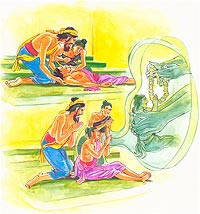 |
Verse 43. Well-Trained Mind Excels People
Explanation: Well directed thoughts can help a person better |
| |
|
|
| |
|
|
| |
|
Rector
JC

INSIGHT-NET- Online A1 (Awakened One) Tipiṭaka Research & Practice University in Visual Format (FOA1TRPUVF)
Online A1 (Awakened One) Tipiṭaka Research & Practice University in Visual Format (FOA1TRPUVF)
From
PRABANDHAK

 |
Verse 21. Freedom Is Difficult
Explanation: The path to the Deathless is the perpetual awareness |
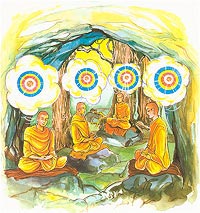 |
Verse 22. Freedom Is Difficult
Explanation: Those who are truly wise are especially aware |
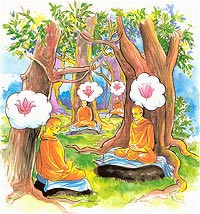 |
Verse 23. Freedom Is Difficult
Explanation: Those wise individuals |
 |
Verse 24. Glory Of The Mindful Increase
Explanation: If a person is persevering, attention focused |
 |
Verse 25. Island Against Floods
Explanation: The whole world is full of defilements. The sensualities |
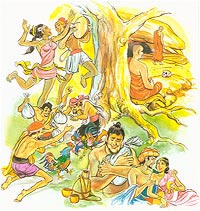 |
Verse 26. Treasured Mindfulness
Explanation: Those who are foolish and indiscriminating |
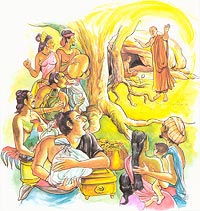 |
Verse 27. Meditation Leads To Bliss
Explanation: Do not indulge in heedlessness. Avoid craving |
 |
Verse 28. The Sorrowless View The World
Explanation: The wise person is always mindful. Through this |
 |
Verse 29. The Mindful One Is Way Ahead Of Others
Explanation: The extremely wise individual of deep wisdom |
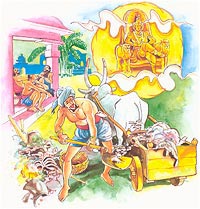 |
Verse 30. Mindfulness Made Him Chief Of Gods
Explanation: The brahmin youth Magha, through his mindfulness, |
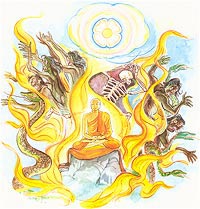 |
Verse 31. The Heedful Advance
Explanation: The monk, as the seeker after the truth, is frightened |
 |
Verse 32. The Heedful Advances To Nibbana
Explanation: The monk as the seeker after |
| |
|
|
| |
|
|
| |
|

Rector
JC

INSIGHT-NET- Online A1 (Awakened One) Tipiṭaka Research & Practice University in Visual Format (FOA1TRPUVF)
Online A1 (Awakened One) Tipiṭaka Research & Practice University in Visual Format (FOA1TRPUVF)
From
PRABANDHAK












